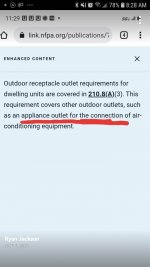I'm really not following you here. The electronics, being inside the breaker, and on the load side of where the overcurrent device opens the circuit to boot, are part of the branch circuit not the feeder. Just another outlet in the circuit.. Lots of branch circuits have more than one outlet.
I'm applying your unitary approach, that is part of the receptacle is the outlet, the whole receptacle is an outlet (similarly for the EVSE). So if part of the AFCI circuit breaker is utilization equipment, the only thing is utilization equipment. So the feeder supplying it is a branch circuit for that utilization equipment.
Let me reiterate the definitions here, and continue in a subsequent post.
Device. A unit of an electrical system, other than a conductor, that carries or controls electric energy as its principal function.
Premises Wiring (System). Interior and exterior wiring, including power, lighting, control, and signal circuit wiring together with all their associated hardware, fittings, and wiring devices, both permanently and temporarily installed. This includes one of the following:
(1) wiring from the service point or power source to the outlets
(2) wiring from and including the power source to the outlets where there is no service point.
Such wiring does not include wiring internal to appliances, luminaires, motors, controllers, motor control centers, and similar equipment. (CMP-1)
Outlet. A point on the wiring system at which current is taken to supply utilization equipment.
Utilization Equipment. Equipment that utilizes electric energy for electronic, electromechanical, chemical, heating, lighting, or similar purposes.
Cheers, Wayne

